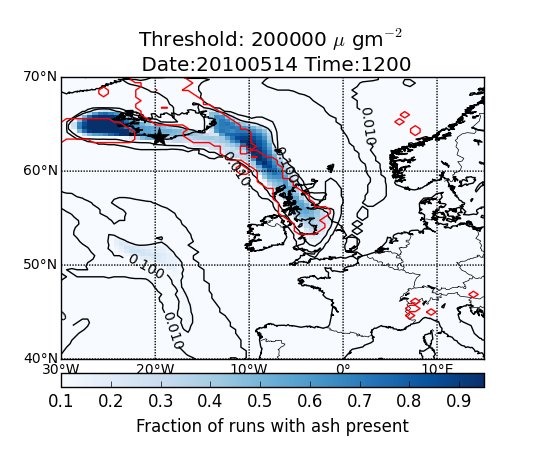Menu
Volcanic Ash
Until March 2016 I worked as a postdoctoral researcher on the Robust Assessment and Communication of Environmental Risk (RACER) project. I work closely with Helen Dacre at the University of Reading and project partners at the UK Met Office and Durham University.The aims of the volcanic ash strand of the project were:
- Develop a methodology for assessing source, parameter and structural uncertainty in dispersion models
- Quantify the relative importance of different sources of uncertainty and hence identification of measurements needed to constrain uncertainty
- Combine multiple uncertainties into a single probabilistic volcanic ash forecast.
In this project we are focusing on a case study from the 2010 eruption of Eyjafjallajökull eruption. This eruption disrupted European airspace for 13 days leading to the cancelation of 95,000 flights causing an estimated global financial loss of $5 billion. Due to the disruption caused this is one of the most well observed ash clouds and therefore an ideal case study.
The dispersion model that we are using to develop the methodology for assessing uncertainty is the Numerical Atmospheric-dispersion Modelling Environment NAME model. This model was developed at the UK Met Office following the 1986 Chernobyl disaster. It is used operationally by the London Volcanic Ash Advisory Centre (VAAC) to provide information and advice to the relevant authorities after an eruption.
To assess the relative importance of different sources or error our colleagues at Durham are building an emulator of NAME. An emulator is a statistical representation of complex model. Once validated, this emulator will provide us with information about which sources of uncertainty contribute most to the uncertainty of volcanic ash forecasts. For more details see my poster or my recent PURE network blog.
The final aim of the project is to produce a probabilistic forecast of volcanic ash. Using output from a 300 member ensemble of NAME runs used to build the emulator I have produced a very basic probabilistic forecast of ash column loading for 12UTC on 14 May 2010 (shown below). The red line denotes SEVIRI satellite retrievals of ash at the same time on 14 May. Note that this assumes an ash cloud depth of 1km (consistent with contemporary observations) and a column loading threshold value being applied (see plot for value).

I recently attended the NAME users meeting at the Met Office and presented my work on reducing the risk of volcanic ash to aviation. This also includes work on objectively quantifying the spatial accuracy of volcanic ash forecasts using a neighbourhood approach.
This work was also presented at the PURE Volcanic ash workshop: forecasting challenges at the Royal Academy of Engineering on 22 February 2016. A summary of the meeting can be found here on the PURE network blog.
Poster summarising emulation work: Reducing the risk of volcanic ash to aviation
Poster summarising summer student work: Testing the structural uncertainties in volcanic ash cloud predictions and their impact on aviation